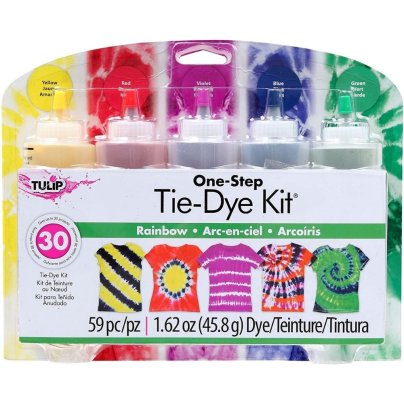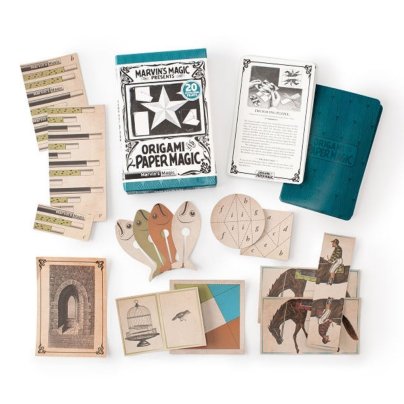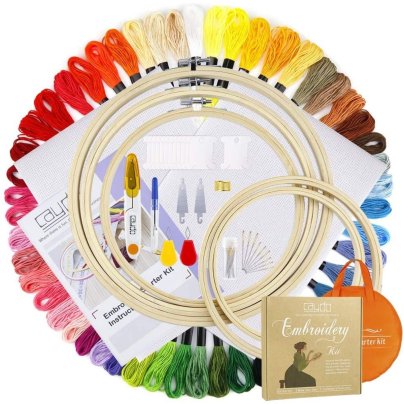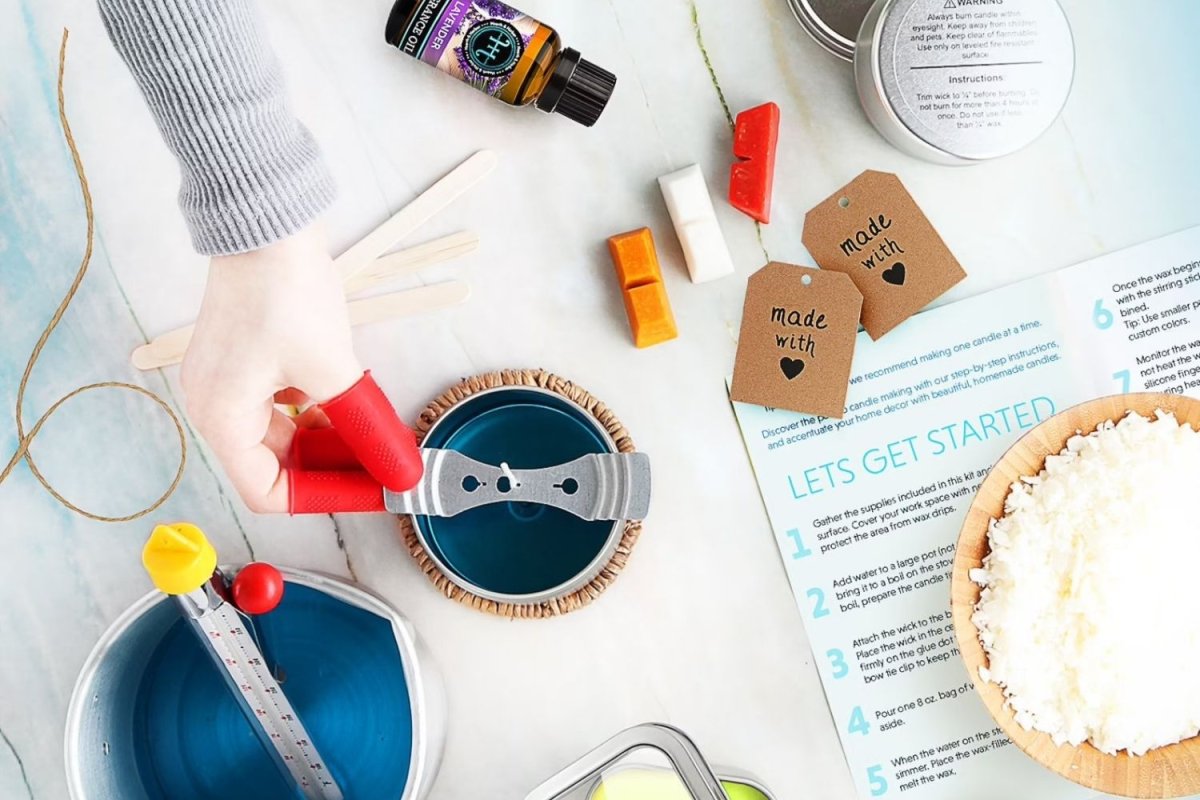
We may earn revenue from the products available on this page and participate in affiliate programs. Learn More ›
Regardless of how naturally crafty the person you’re buying for is, craft kits for adults can be both educational and entertaining, not to mention stress-reducing. From kits that make trendy, chunky scarves to others that bring out the artist in the recipient, these gift options offer an opportunity for users to look away from their devices and focus on being creative and crafty. Plus, there’s no need for expensive appliances or gadgets to complete these projects; everything the crafter needs is included in these craft kids. Whether you’re shopping for a birthday gift or a gift to offer at a housewarming party, the following craft kits for adults are appropriate for a variety of occasions.
Discover More of the Best Craft Kits for Adults on Etsy
The Best Craft Kits for Adults
Whether you’re on the hunt for a present that can be worn, displayed, or done just for fun, the following craft kits for adults offer something for beginner, intermediate, and expert crafters alike.
Gifts Under $25

Tulip One-Step 5 Color Tie-Dye Kits
Crafters can create their own tie-dye project of choice with Tulip One-Step 5 Color Tie-Dye Kits, each of which includes five squeeze bottles with dyes and eight tie-dye looks to choose from. It’s a simple, easy activity to do with kids or other family members who want to see their designs come to life. This kit comes with enough supplies to make 30 different projects and can be used on cotton, rayon, and wool. Plus, the dyes are safe to machine wash, so T-shirts, dresses, or tank tops will stay bright and colorful over time. $10 on Amazon.

Origami Paper Magic Kit
When it’s time to set the screens aside, this Origami Paper Magic Kit provides educational entertainment for the whole family. With this kit, users can create up to 20 intricate works of paper art, thanks to helpful instructions that provide a guide for each fold. This child-friendly activity not only teaches an ancient art but promotes hand-eye coordination, geometry skills, and problem solving. $15 on Uncommon Goods.
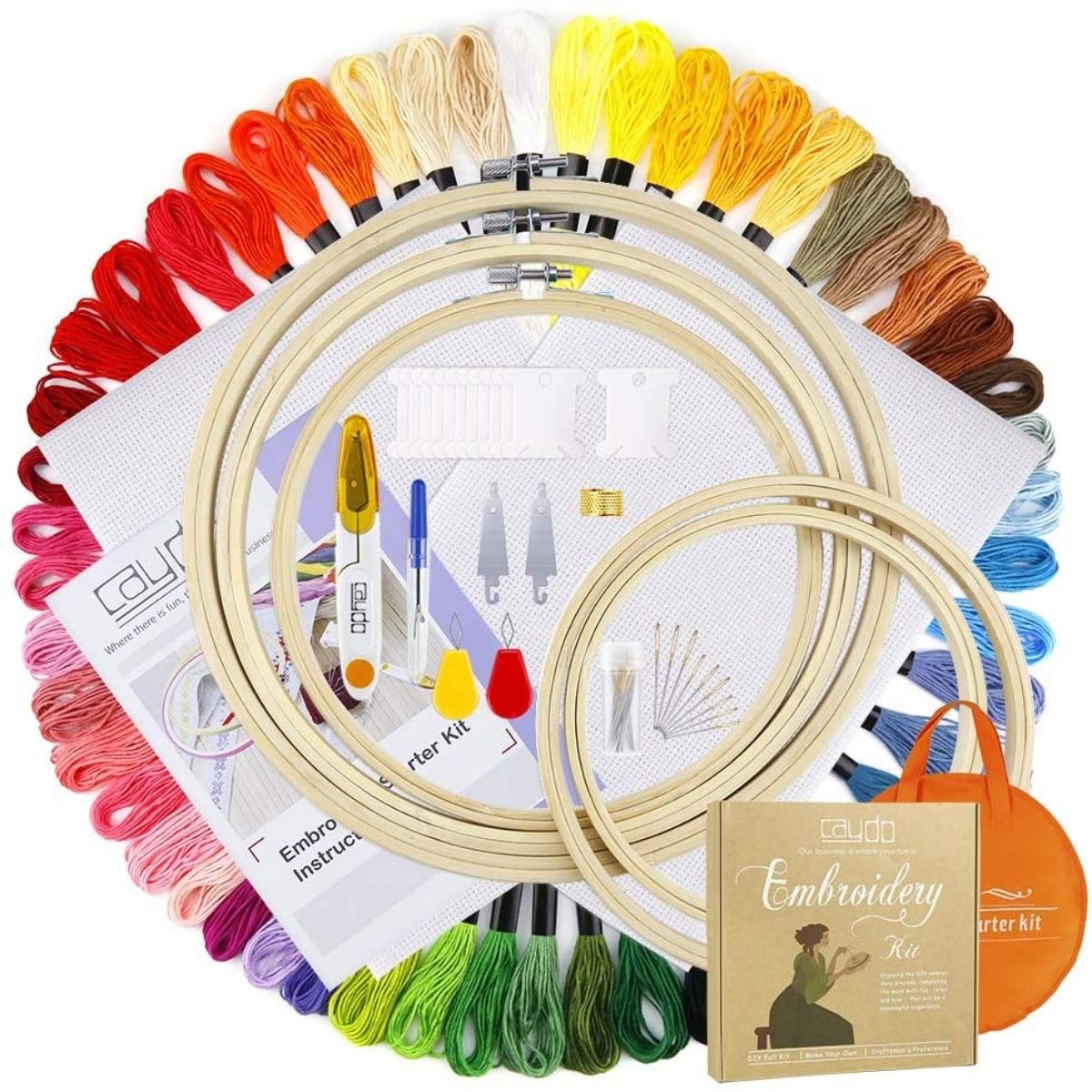
Caydo Full Range of Embroidery Starter Kit
The Caydo Full Range of Embroidery Starter Kit is suitable for beginning embroiderers who want to avoid multiple trips to the craft store to complete their first piece of embroidery. The kit is an excellent resource as it includes all the tools crafters need to complete a piece, including wooden hoops, cloth to embroider on, color threads, scissors, a thimble, bobbins, needles, and helpful instructions. The kit also provides enough materials for different sizes of embroidery projects and patterns to enhance a beginning embroiderer’s enjoyment. $16.99 on Amazon.

Nuberlic 3 Sets Embroidery Kit for Adults
Cross-stitching has been around for ages, and for good reason. The art of embroidery has helped mark important events, such as births or weddings, and makes for beautiful decor. The Nuberlic 3 Sets Embroidery Kit for Adults is an excellent gift option for someone who wants to learn how to cross-stitch but hasn’t started yet. It comes with three decorative floral patterns, as well as the hoops, needle, and thread for each. Plus, the printed pattern and included instructions make getting started a breeze. $16.99 on Amazon.

J MARK 22-Piece Acrylic Painting Kit
PROMOTED PICK
Unleash your inner Picasso, Van Gogh, or Monet with this painting kit. It comes complete with everything someone needs to get started on a big masterpiece: wooden easel, canvas, acrylic paints, palette, and brushes. The acrylic paints are easy to work with and wash, unlike other types of paint, so switching between colors and cleaning up is a breeze. Painting is a great activity to let creativity flow and release stress—especially for adults—and this kit would make an ideal gift for any artistic friend, family member, or even yourself. $18.99 on Amazon.

Craft Crush – Mini Terrariums Craft Kit
No extra trips to the store for supplies are needed for the Craft Crush Mini Terrariums Craft Kit. This set is a great gift option for people who may not have a green thumb but like the warmth that greenery can bring to the indoors. The kit produces three mini terrariums with felt succulent plants that require zero watering. Add the faux moss and pebbles and voilà—three mini terrariums are built inside the geometric containers. Users can display them together or give one or two away as gifts. Either way, it’s a versatile craft kit that suits a wide range of people. $19.99 on Amazon.

Hedgehog Needle Felting Kit
The Hedgehog Needle Felting Kit is a top gift option for someone looking for a new hobby or interested in learning how to needle felt. This beginner-level set comes with the tools, step-by-step instructions, and wool needed to make two or three adorable felted hedgehogs that are great to display or play with. Plus, users can repurpose leftover wool and the included tools to create new items once they’ve learned the basics of needle felting. $20 on Uncommon Goods.

Lettering Tribe Calligraphy Set For Beginners
A terrific gift for someone who enjoys hand lettering or writing notes and letters, the Lettering Tribe Calligraphy Set for Beginners is a complete set for users who are new to the calligraphy world. It comes with ink, a wooden pen, 10 stainless steel nibs, plus a booklet to get writers started with tips, tricks, and pages to practice on. The included ornamental nib holder makes writing at a slant a cinch, and the set comes with both black and walnut-colored ink to get different effects. $22.97 on Amazon.
Gifts $25 to $50

DIY Organic Bath Bomb Kit
For the self-care enthusiast who appreciates quality ingredients, this DIY Organic Bath Bomb Kit makes soaking in the tub an indulgent experience. These bath bombs are made with all-natural ingredients such as chamomile, rose petals, and lavender, so the user won’t have to worry about drenching their skin in products full of harmful chemicals. This set has all the necessary ingredients to create fizzy bath bombs at home, plus instructions on how to put everything together properly and materials to wrap the end product. $25 on Uncommon Goods.
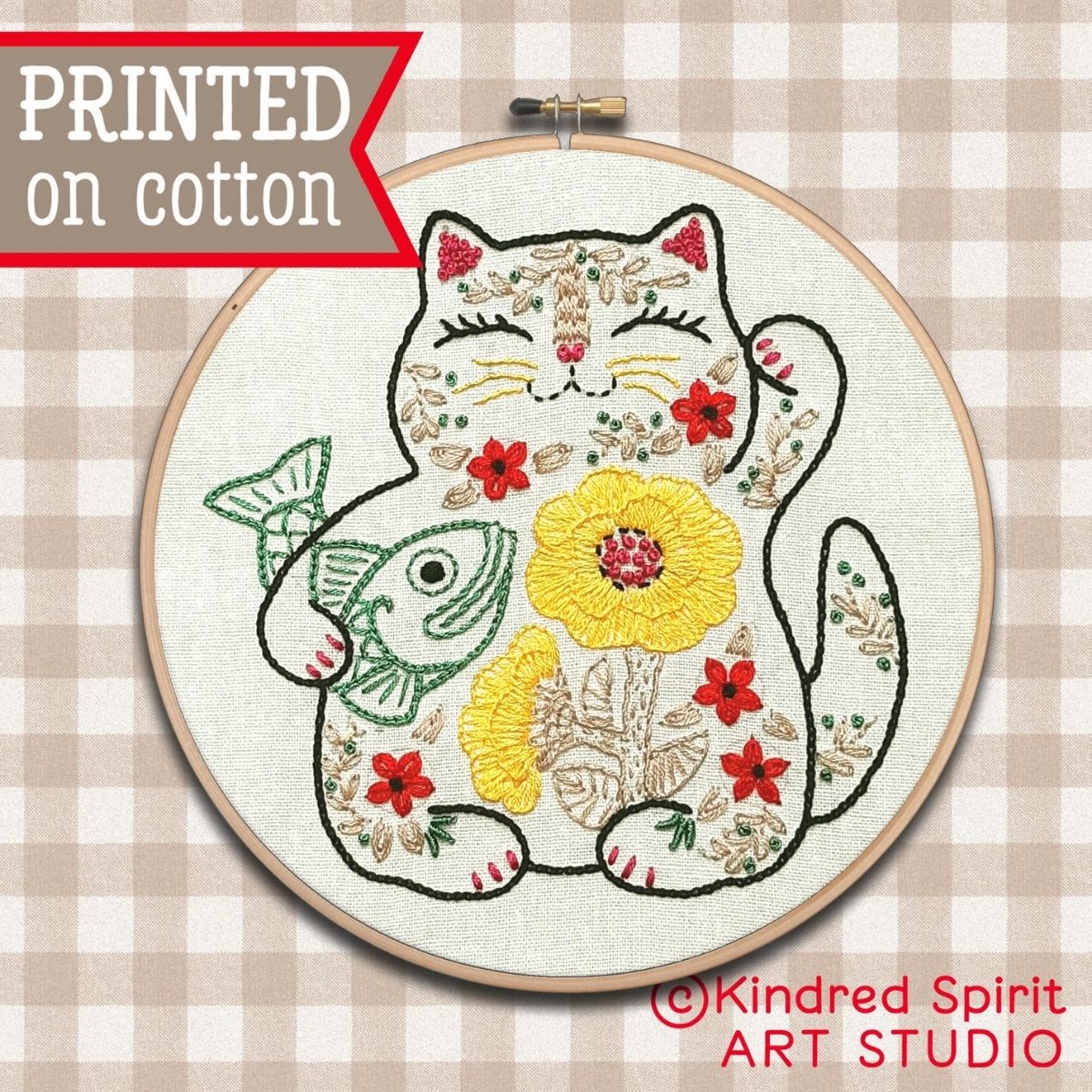
Cat Embroidery Kit
Cat lovers who enjoy crafting can have a heyday with the Cat Embroidery Kit, which features an adorable cat pattern that’s simple enough for even beginning crafters to complete. Users will be able to hand embroider the maneki-neko design which represents a lucky Japanese cat that is said to bring good luck, fortune, and good things. Tracing and transferring won’t be an issue with this kit, since the backing is 100 percent cotton/linen. This kit comes with detailed instructions, pre-printed fabric, a hoop, and other accessories. Starting at $25.14 on Etsy.

DIY Macrame Kit for Adults
If the person you’re shopping for could benefit from a stress-reducing activity, this DIY Macrame Kit for Adults is an excellent gift option. Macrame, or knot tying, has proven to be a calming practice that can improve concentration. Plus, it produces beautiful, cozy projects when completed. This kit comes with all the materials and instructions to create three designs: a wall hanging, a plant hanger, and a keychain. It’s also a great gift for beginning to expert crafters. $27.95 on Etsy.

Woolbuddy Needle Felting Starter Kit
A great gift for crafters with kids, the Woolbuddy Needle Felting Starter Kit includes all the felting tools users will need to create the cutest felt animals, including an owl, a fox, and a shark. Each 1- to 2-inch character can be finished within an hour or two, so the kit is a great set for beginners or crafters with no prior needle-felting experience. Step-by-step instructions with detailed photos are also included in the set to guide users through the process. Users can even include their kids or other family members in the fun by letting them select color and design choices or even having them help with the needling. $28 on Amazon.
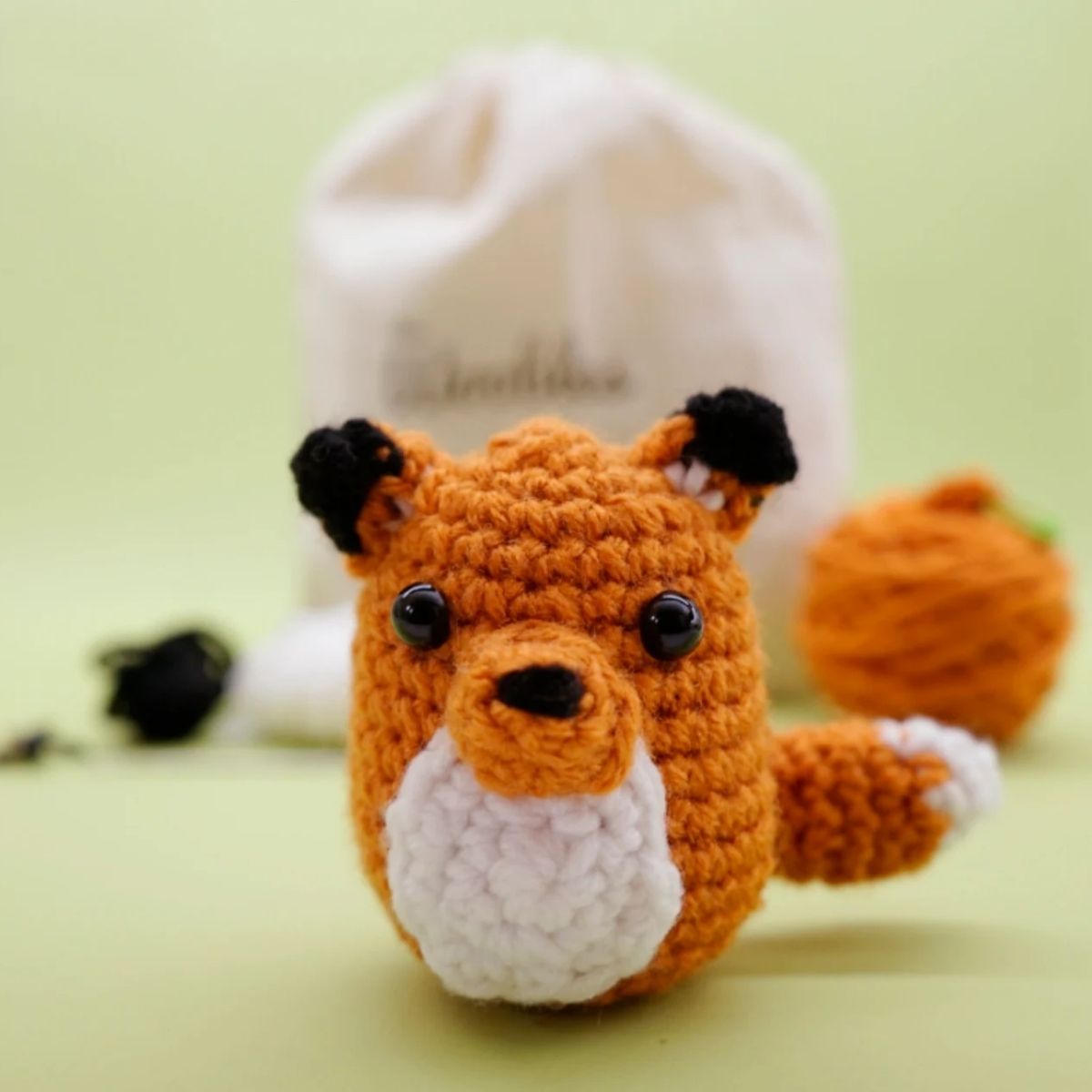
The Woobles Beginner Learn to Crochet Kit
The Beginner Learn to Crochet Kit is an excellent introduction to the art of crocheting, and the result is an adorable fox from The Woobles. Although this kit presents a few tricky techniques, the work can certainly be tackled by a beginner as well as an advanced crocheter. The cute fox made from this kit can also be given as a gift or kept as a keepsake to remember a first project. This kit comes with video tutorials for right and left-handed people, as well as a pre-started crochet piece, plastic eyes, stuffing, a needle, acrylic yarn, stitch marker, and a drawstring bag to keep everything together. $28.57 on Etsy.
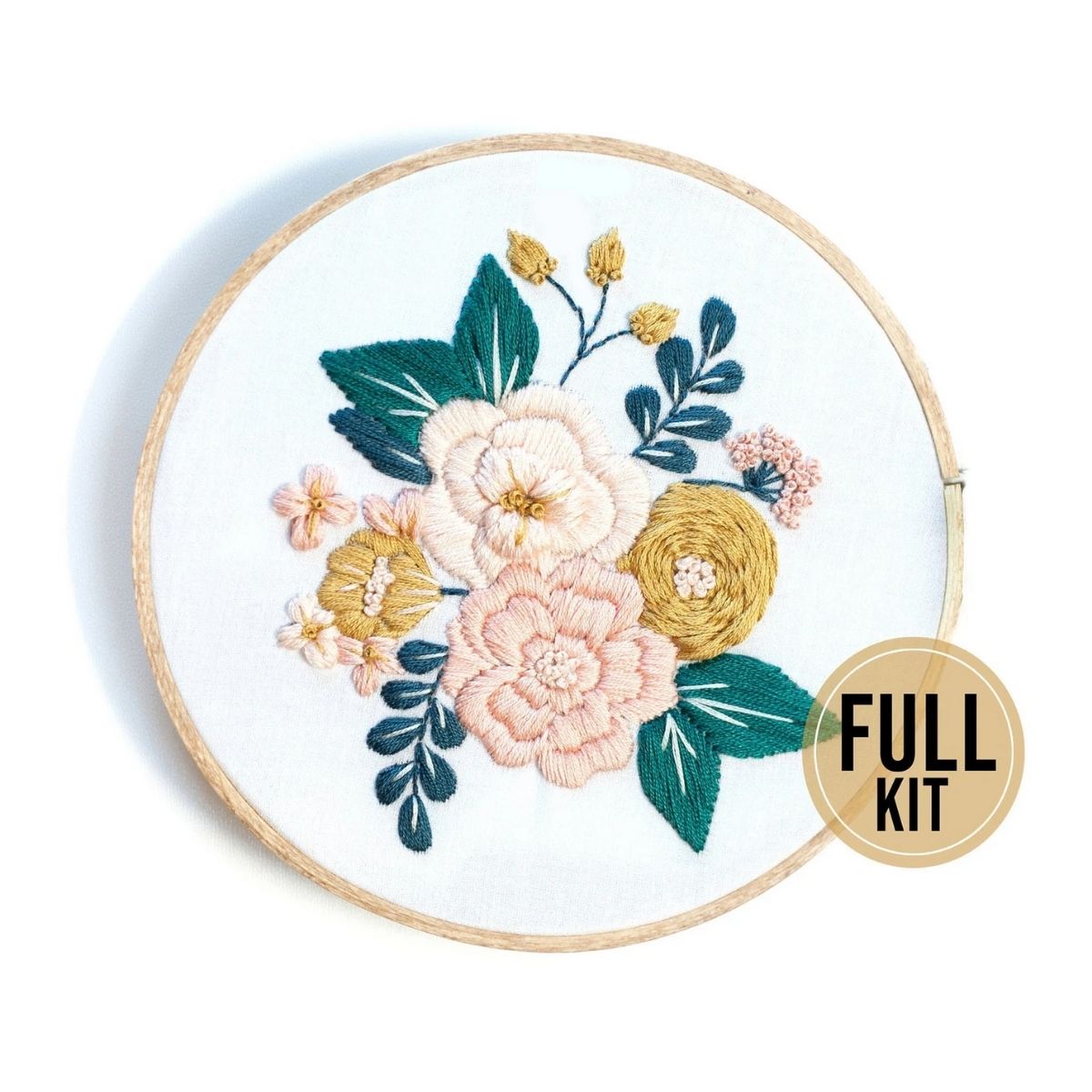
Embroidery Kit Beginner
Needle masters and beginners alike can sit down with the embroidery kit for beginners for a relaxing, quiet activity that can be enjoyed by itself or while watching a movie or TV show. The kit comes with printed cotton fabric for the background, an embroidery needle, a wood embroidery hoop, embroidery floss, and printed instructions to guide the user from start to finish. This set produces a beautiful floral design that can be hung in an office, apartment, or child’s room and is a great way to get crafters using their hands to create. Starting at $32.73 on Etsy.

Floral Hoop Wreath Kit
The Floral Hoop Wreath Kit is a great gift for crafters who enjoy making their own home decor or decorating for different seasons. This kit comes with a 19-inch gold hoop that can be customized according to the user’s liking. Hoops can be decorated with eucalyptus, peonies, and roses, and the included wire cutters, floral wire, and floral tape help make it a sturdy wreath that can withstand the outdoor elements. $34 on Adults & Crafts.

Mug Stand and Customizable Mugs Kit
Users can create their ideal coffee corner with this Mug Stand and Customizable Mugs Kit. This craft kit for adults comes with precut wood pieces, two mugs, a Sharpie, white paint, and black hooks for a completely blank slate. With the included Sharpie, users can write their own nicknames, a funny quote, or a term of endearment for someone else if giving it as a gift. Plus, the stand takes up little room on a counter and is a great way to keep the kitchen organized. $34 on Adults & Crafts.

DIY Goat Milk Soap Making Kit
Whether it’s made by one person or an entire DIY party, this DIY Goat Milk Soap Making Kit makes four 4-ounce bars of rich lather to keep the body hydrated and clean. It’s an excellent introductory kit for someone who has never made their own soap before, and the process can be done solo or with a group of crafters. From essential oils to oats and clay, all the ingredients needed to create the soap are included in this kit, as well as the recipe and instructions on how to put it together. $34.99 on Etsy.
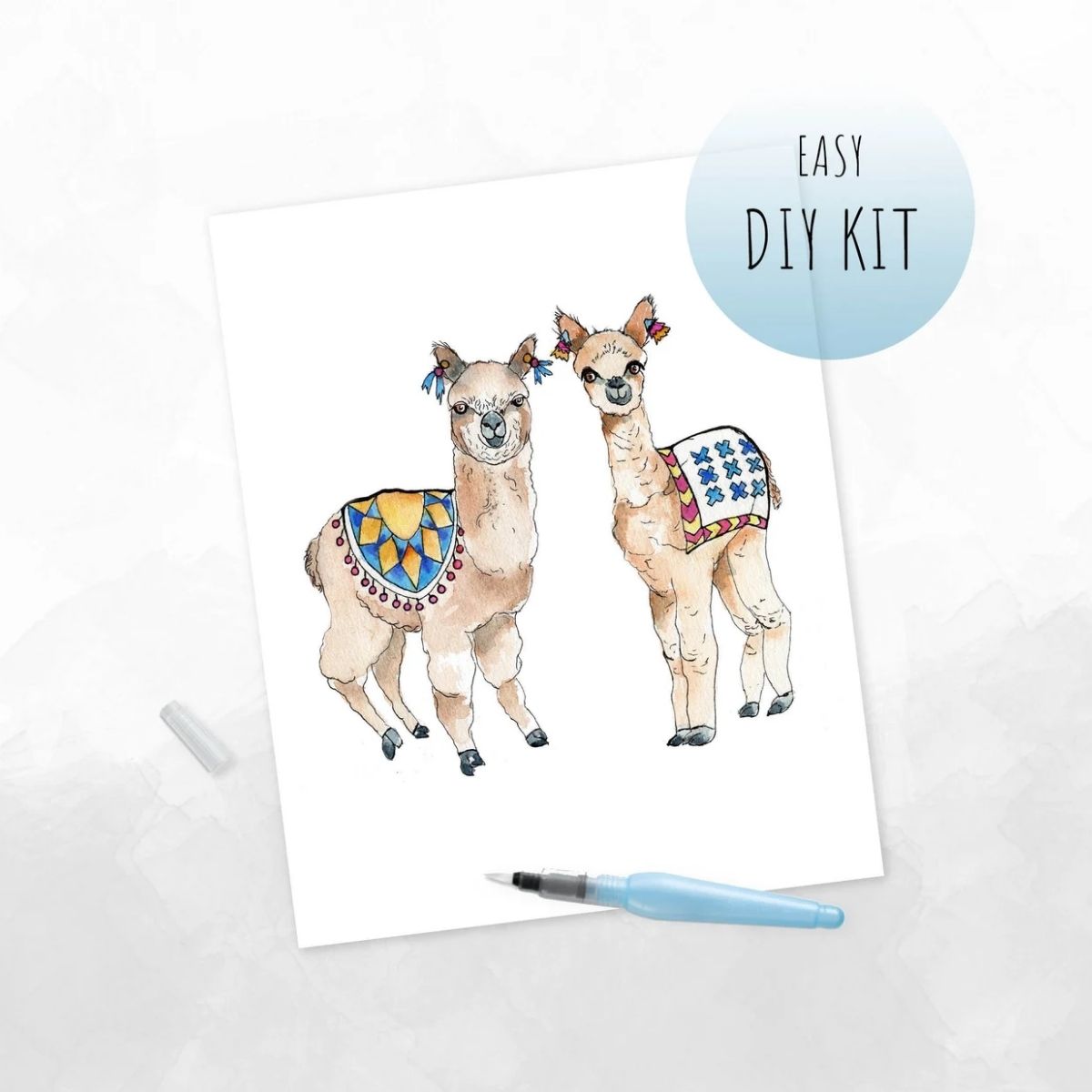
DIY KIT- Watercolor Mr. & Mrs. Alpacas
Users won’t need to go to a workshop to learn how to watercolor thanks to this watercolor kit. Since painters don’t have to draw the outline of this watercolor, it makes the process much simpler and easy to finish. All users have to do is follow the provided instructions and color in the outlined alpacas with the built-in paint palette. It’s an excellent starter kit for beginners or a great way to involve friends and family in a group activity if you order more than one. The kit comes with instructions, a practice guide, a paint palette, a brush pen, and a pre-outlined image. $36.43 on Etsy.

Personalized DIY Kit, Mosaic Kit
This Personalized DIY Mosaic Kit can be completed alone or with a group, for recipients who like either group or solo activities. Users can create a completely custom coaster or trivet with the precut mosaic tiles in the color of their choosing for a maximum of five colors. The set comes with one 6-by-6-inch coaster or two 4-by-4-inch coasters, tiles, a sponge, gloves, grout, glue, and instructions on how to put the design together. It’s a great option for friends or families with an artistic side or who like to make handmade housewares. $38 on Etsy.

Woodburning DIY Craft Kit
It’s OK to play with fire with the Woodburning DIY Craft Kit, which lets users burn in their own designs on a piece of natural wood. The kit comes with the wood product of choice, plus a wood burning tool, practice wood, transfer paper, foam brush, gloss varnish, paint, and a paintbrush. Crafty adults can burn their names, a logo, a favorite quote, or another design to showcase at their next gathering. It’s a one-of-a-kind way for them to make their mark at home. $39 on Etsy.

DIY Preserved Moss Frame Kit
For the nature lover who wants to bring the outdoors inside, the DIY Preserved Moss Frame Kit is a top-rated gift to give. Users can create their own masterpieces with the included moss, lichen, ferns, and flowers set inside a 10-inch by 10-inch pinewood frame. The setting can be customized to each crafter’s preference with the provided glue gun, and once finished, the piece of preserved art can be hung on a wall or displayed in a bookcase. $45 on Uncommon Goods.

Pixiss 16 Colors Acrylic Pour Paint Kit
The Pixiss 16 Colors Acrylic Pour Paint Kit is a terrific gift for the artistic friend who likes to explore new techniques on canvases, coasters, plaques, planters, and more. The paint-pouring technique can create endless unique pieces when the user mixes the included paint, silicone, and Floetrol. The colors blend through layers in a cup, and once the cup is tipped over on the canvas and lifted, the colors flow outward. Users can use this bundle to create artwork for the home or give as gifts to loved ones. $47.99 on Amazon.

Eco-friendly DIY Earring Kit
For the person in your life who loves to sport the latest accessories, this Eco-friendly DIY Earring Kit is a thoughtful gift that produces one-of-a-kind pieces. The kit is created for beginners or experienced crafters and comes with 26 cork fabric pieces in a wide range of shapes and styles. Other items, like earring hardware, metal embellishments, flat nose pliers and muslin bags, are also included to help make jewelry making a cinch. The kits also make for a great group activity, whether in-person or virtual. $48 on Etsy.
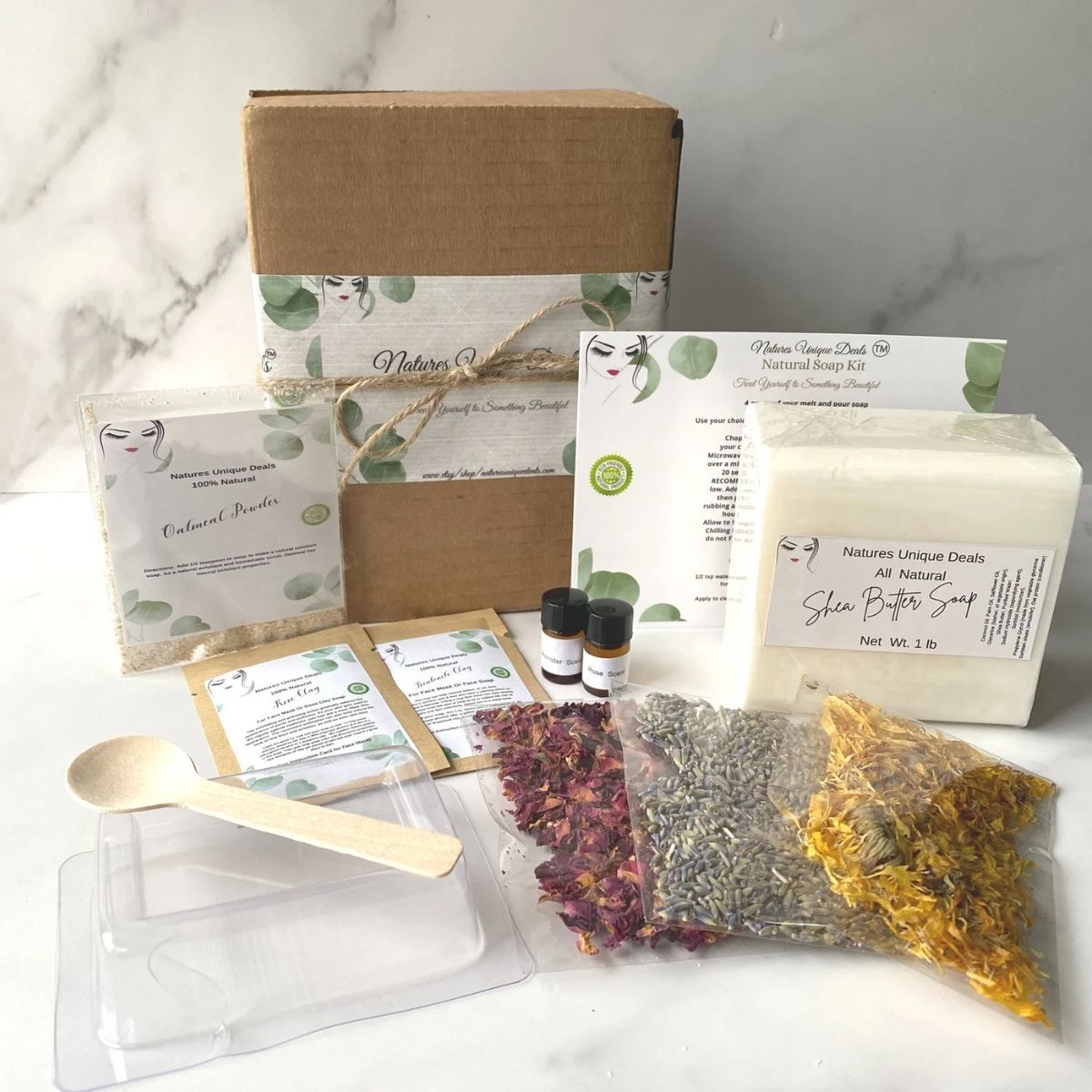
DIY Shea Butter Soap Making Kit
Soap is usually a staple in every household, and this DIY Shea Butter Soap Making Kit allows users to make their own with quality ingredients that won’t irritate the skin. The kit makes four 4-ounce bars of soap and provides a hands-on activity that can be done solo or with a group. It comes with everything users need to make the soap, including recipes and instructions, a soap mold, organic oats, fragrance, clay, and dried rose petals and buds. $49.99 on Etsy.
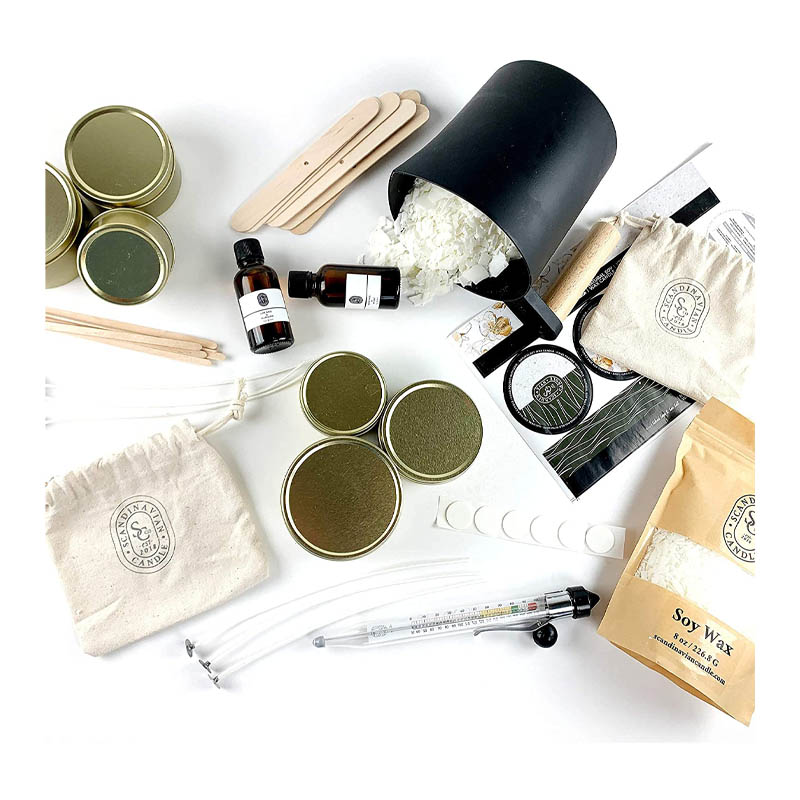
Scandinavian Candle Co. Luxury Soy Candle Making Kit
PROMOTED PICK
Whether for birthdays, Mother’s Day, or Christmas, the candles created from the Luxury Soy Candle Making Kit for Adults make welcome gifts, no matter the occasion. This complete candle-making kit comes with detailed instructions on how to make handmade candles at home. From wax bags and dye blocks to fragrance oils and sleek jars, all the materials the user could possibly need are included in this set. The crafter can choose between sophisticated scents like lime, basil, and mandarin or wood sage and sea salt. $49.99 on Amazon.
Gifts $50 to $100

Elegance Outlander Cowl Knit Kit
When temperatures start to drop and the air gets crisper, the Elegance Outlander Cowl Knit Kit provides the perfect opportunity to create a cozy, chunky cowl scarf to wear all season long. The kit is ideal for crafters with a basic skill level who have a spare weekend to spend knitting this sumptuous scarf. This set produces a one-size-fits-all scarf, and proceeds help support independent artisans, local farms, and fiber mills who helped create the yarn and the dye used to create the amethyst color. $54.95 on Amazon.

Electomania DIY Canvas Painting Kit
Whether it’s used by serious artists or those who want to try their hand at something new, the Electomania DIY Canvas Painting Kit can be used by adults and kids as a way to exercise their creative minds. This canvas painting kit comes with three brushes, a set of acrylic paints, and a pre-printed textured canvas for a set that eliminates the hassle of buying or searching for specific materials. The guided numbers help beginners learn how to layer colors and shapes to produce a painting that’s worthy of a spot on the wall. $60 on Amazon.
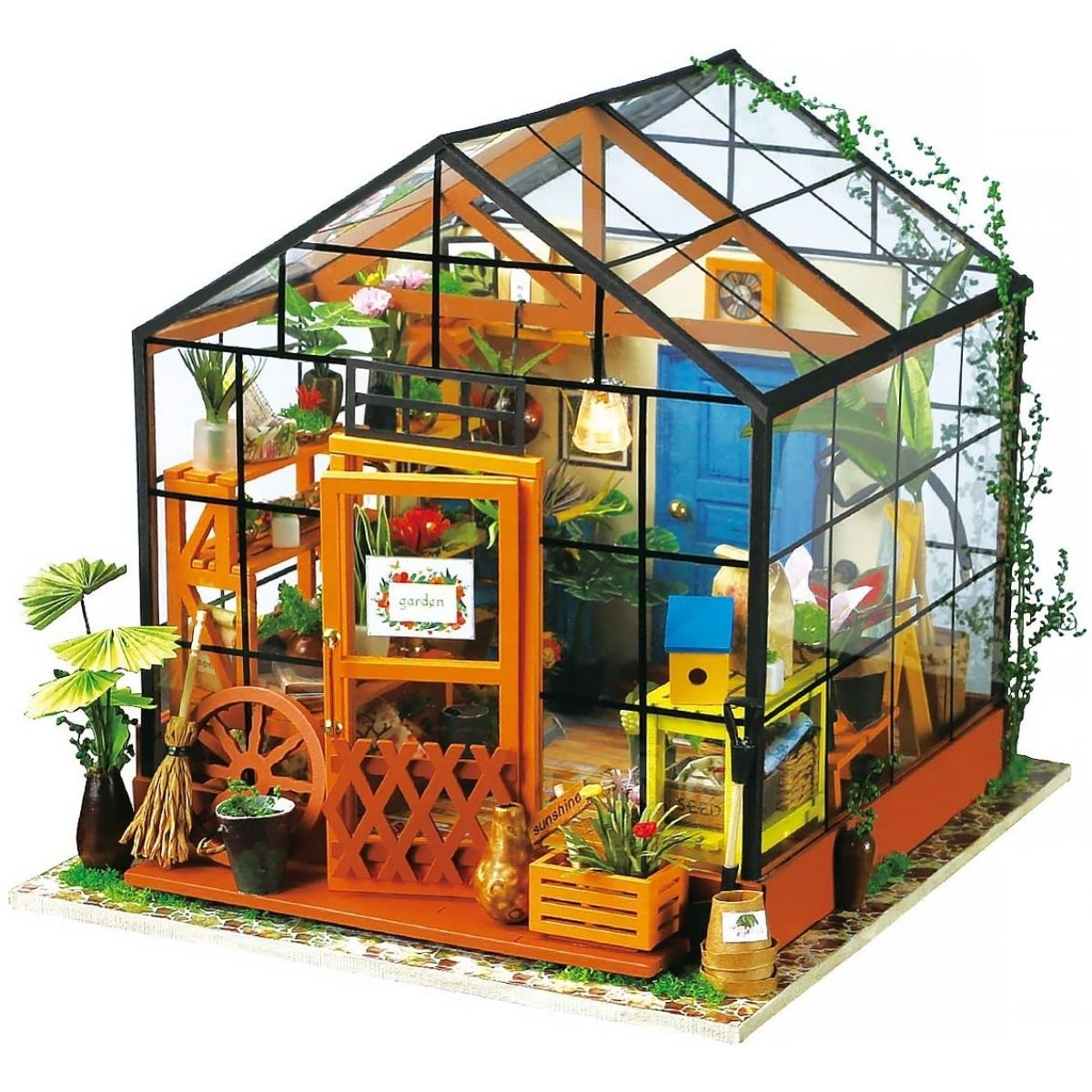
DIY Miniature House: Cathy’s Flower House
Adults who have fond memories of playing with dollhouses growing up can channel their inner child with the DIY Miniature House: Cathy’s Flower House. Users can design and create their own room that acts as a 3D puzzle with tiny furniture and accessories. This kit specifically helps users bring a tiny greenhouse to life with wood, fabric, metal, paper, and real light fixtures with LED lights inside. The kit comes with all the tools needed to put the flower house together and includes glue, button cells, tweezers, pigment, and a brush. $61.36 on Etsy.

Watercolor Tutorial Step by Step
For crafty adults who also travel often, the Watercolor Tutorial Step by Step Art Painting Kit is a convenient way to pass the time in the car or on a long flight. The kit comes in a portable, protective box that can store the included art board, color palette, brush, guide booklet, transfer paper, design sheet, towel, and pencil. Once it’s complete, painters will be left with a vibrant floral and prickly pear cactus print that they can display in their homes to show off their skills. The kit offers a great way to practice watercolor painting for beginners or seasoned experts. $70 on Etsy.
Gifts $100 to $250

SEAAN Electric Pottery Wheel Machine
It may seem intimidating to create pottery at home, but the SEANN Electric Pottery Wheel Machine makes it an easy craft to complete from virtually anywhere. One can change the wheel speed easily thanks to its pedal and LCD touch-screen controls. The touch screen can be used even if users’ hands are messy or full of clay. Removable splash pans make it easy to clean, and the machine’s low noise and compact size make it easy to transport or use with a house full of other people. The wheel’s variable speeds allow users to switch from centering, trimming, and throwing like they’ve been spinning pottery for years. $204.99 on Amazon.
How to Choose the Best Craft Kits for Adults
To find the best craft kits for adults, you may want to consider a few factors before you start your online or in-person shopping. Once you’ve selected the person you’re shopping for, consider the following:
- What level crafter is the recipient? The kit you select may cater to a specific skill level, so it’s important to know if whom you’re shopping for is a beginner or an expert crafter.
- What type of crafts do they enjoy? If they prefer simpler and repetitive tasks like cross-stitching or felt needling, you won’t want to give them an acrylic paint set that they may not enjoy using.
- What is your price range? Once you identify your budget, you can look for specific gifts within that category to make shopping easier.
How to Get the Best Craft Kits for Adults Deals
If you’re looking for the best deals on craft kits for adults, you’ll need to look into online resources like Honey that will notify you when items you’ve been tracking are discounted and search the web for coupon codes. Honey is a simple yet savvy browser extension that tracks the prices of products for you, so you don’t have to do the heavy lifting yourself. Retailers such as Walmart and Target also offer price matching on items, so you can snag certain kits and other gifts at the lowest prices possible.
It’s also advised to look out for discounts around Black Friday or Cyber Monday, when retailers slash prices on items around the holidays. Even if you don’t plan on giving these craft kits for adults as Christmas gifts, you can stock up on items for a fraction of the cost that you can gift later.
Prices listed here were accurate at the time of publication on 9/14/2021.
